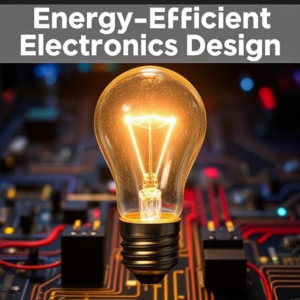What is Energy-Efficient Electronics Design?
Energy-efficient electronics design refers to creating and building electronic devices and systems that use less energy to do the same job. This is important because energy efficiency helps reduce electricity consumption, which can save money, reduce environmental impact, and prolong the lifespan of devices.
Think about it like this: if you have a lightbulb that gives the same amount of light as another one but uses less power, it’s more energy-efficient. In electronics, this idea applies to everything from your phone to computers to big machinery.

Why is Energy-Efficient Design Important?
- Saves Energy: Using less energy means consuming fewer resources like electricity, which helps reduce our carbon footprint and the demand for energy.
- Lower Costs: Devices that consume less power lead to lower electricity bills for users and businesses.
- Longer Battery Life: For portable devices (like smartphones or laptops), being energy-efficient means batteries last longer before needing a recharge.
- Environmental Impact: Using less energy helps reduce pollution and the need for power plants, which helps protect the environment.
How is Energy-Efficient Design Achieved?
Here are some ways engineers and designers make electronics more energy-efficient:
1. Low-Power Components:
- What it is: Using components that need less power to operate, like energy-efficient processors (the “brain” of the device) and low-power sensors.
- Example: New smartphones use processors that are designed to run on less power but still perform well.
2. Optimized Circuits:
- What it is: Creating circuits that minimize energy waste. This can involve using smart design techniques that make sure energy isn’t lost as heat or through inefficient paths.
- Example: Designers might use circuits that “sleep” or power down when they’re not being used, saving energy.
3. Power Management Systems:
- What it is: These are systems that control how energy is used in a device. They make sure that different parts of the device get only the power they need, when they need it, and not more.
- Example: In a laptop, power management might switch off the screen when you’re not using it, or adjust the CPU power based on the tasks you’re doing.
4. Efficient Power Supply:
- What it is: The power supply is the part of the device that brings in power from a battery or wall outlet. Efficient power supplies waste less energy as heat and convert more of the input energy into useful power for the device.
- Example: Modern laptops and TVs have energy-efficient power adapters that reduce wasted energy during charging.
5. Use of Renewable Energy:
- What it is: Sometimes, energy-efficient designs involve using renewable energy sources (like solar or wind) to power electronic devices, reducing dependence on fossil fuels.
- Example: Solar-powered calculators use solar panels to charge their batteries instead of relying on electrical outlets.
6. Reducing Idle Energy Use:
- What it is: Many electronic devices use power even when they aren’t being used (this is called “standby power” or “phantom power”). By designing devices that automatically turn off or go into low-power modes when not in use, you can save energy.
- Example: Modern TVs and computers automatically switch to “sleep” mode when not in use, reducing power consumption.
Energy-Efficient Design in Different Devices:
- Smartphones: Designers focus on optimizing battery life through energy-efficient screens, processors, and power management systems.
- Computers: Use low-power processors, better cooling systems (to reduce heat waste), and power-saving modes.
- Home Appliances: Refrigerators, air conditioners, and washing machines are designed to use less electricity while maintaining their performance.
- Electric Cars: These cars use energy-efficient motors and regenerative braking systems to maximize battery life and reduce energy consumption.
Conclusion:
Energy-efficient electronics design is all about making devices that use as little energy as possible without sacrificing performance. It involves smart engineering choices like low-power components, optimized circuits, and efficient power management systems. The goal is to save energy, reduce costs, and minimize environmental impact, making life better for both users and the planet.
Tags: carbon footprint reduction, circuit efficiency, dynamic power allocation, eco-conscious electronics, eco-friendly design, efficient power supply, electric vehicles, Energy, energy savings, energy-efficient electronics design, energy-efficient motors, energy-efficient processors., energy-saving modes, environmental impact., green technology, laptops, longer battery life, low power consumption, Low-power components, lower energy costs, optimized circuits, performance without energy waste, phantom power, power management systems, power optimization, reduced electricity use, reduced heat waste, regenerative braking, renewable energy integration, sleep mode, smart appliances, smart engineering, smartphones, solar-powered devices, standby power reduction, sustainable design practices, sustainable electronics


